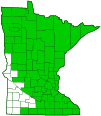American hazelnut
(Corylus americana)
Conservation • Wetland • Description • Habitat • Ecology • Use • Distribution • Taxonomy
Description |
American hazelnut is a fast-growing, deciduous shrub rising on numerous stems from large, horizontal rhizomes usually 4 ″ to 6″ below the surface of the soil. It often forms a dense, rounded clump that can reach up to 30′ in diameter in favorable conditions. It sometimes forms thickets. The stems are slender, straight, and sparsely branched. They are usually 5′ to 10′ tall, but mature stems can reach up to 15′ in height and 1¼″ in diameter at breast height. Outer stems become arching and spreading with age. The bark on young stems is light grayish-brown, shiny, and smooth. On mature stems the bark is somewhat rough, sometimes with finely grooves or ridges. It is not shaggy or peeling. The branches are ascending. First-year twigs are slender and tan to dark brown. They are covered with long, spreading hairs that are red when young, whitish later; and with stalked glands (glandular hairs) that are visible without magnification. They are sticky to the touch. They sometimes become almost hairless near the end of the first season. Second-year twigs are zigzag and hairless. The buds are broadly egg-shaped, about to ⅛″ long and wide, brownish-gray, and unstalked. They are covered with 4 to 6 scales. The outer bud scales are not deciduous, remaining attached throughout the season. Winter buds are rounded, not angled, at the tip. Flower buds and leaf buds are similar in size and appearance. Leaf scars are small and flat or slightly raised, not depressed. They have 3 bundle scars. The leaves are alternate, broadly egg-shaped to broadly elliptic or broadly inversely egg-shaped, 2⅜″ to 4¾″ long, and 1⅜″ to 3⅛″ wide. They are attached to the twigs by ¼″ to ¾″ long leaf stalks. The leaf stalk is covered with long, spreading hairs that are red when young, whitish later, and with glandular hairs that are visible without magnification. It is not sticky or resinous. The leaf blade tapers to a sharp point at the tip and is heart-shaped or rounded at the base. It often has straight sides, giving it a squarish appearance, and is occasionally slightly lobed near the tip. There are 6 to 9 lateral veins on each side of the midrib. The lateral veins are sometimes branched. The upper blade surface is dark green and sparsely hairy. The lower surface is paler green, felty to the touch, and covered with soft, spreading hairs, especially along the larger veins. The margin is irregularly doubly toothed with sharp, forward-pointing teeth. In the fall the leaves turn yellow to orange. Male and female flowers are borne on the same branch. Male flowers appear in late summer singly or in pairs, sometimes in clusters of 3. They are green, slender, cylindrical, drooping clusters of many flowers (catkins). They droop from the leaf axils of twigs of the previous year on woody, ⅛″ to ⅜″ long stalks. They turn brown in the winter. In the early spring they become yellowish and elongate, becoming 1″ to 2¾″ long. The longer male catkins are at least 1½″ long. They shed their pollen in late March to early May. Female flowers are much smaller, compact, reddish-brown catkins that resemble leaf buds. They are concealed by overlapping scales with only the elongated, bright red stigma and styles exposed. They are subtended by a minute bract and a pair of bractlets. The bractlets get much larger with age, becoming the husk of the fruit. The fruits appear singly or in clusters of usually 2 or 3, sometimes 4 or 5. Each fruit is an edible nut enclosed in a leaf-like husk with a short, broad fringe at the end. The husk is ¾″ to 1⅜″ long, ⅝″ to 1 3 ⁄16″ wide, extending 3 ⁄16″ to ¾″ beyond the nut. It is no more than 2 times as long as the fruit. The fruit is sometimes visible. The husk is covered with both glandular hairs and soft, nonglandular hairs. The nut is more or less globe-shaped and ⅜″ to ⅝″ in diameter. It is enclosed in a hard shell. The fruit matures in late August to late September. |
Height |
5′ to 15′ |
Flower Color |
Yellowish male catkins in spring |
Similar Species |
| Beaked hazelnut (Corylus cornuta) leaf stalks and first year twigs do not have stalked glands. Mature male catkins are shorter, no more than 1⅜″ long. The husk surrounding the nut forms a long, narrow tube, not a short, broad fringe. The nut is completely concealed by the husk. |
Habitat |
Dry to moist. Upland deciduous and coniferous forests, especially oak, aspen, and pine forest. Full or partial sun. |
Ecology |
Flowering |
Late March to early May |
Pests and Diseases |
|
Use |
|
Distribution |
||
|
Sources |
|
| 7/11/2024 | ||
Nativity |
||
Native |
||
Occurrence |
||
Common and abundant |
||
Taxonomy |
|
Kingdom |
|
Division |
Tracheophyta (Vascular Plants) |
Subdivision |
Spermatophytina (Seed Plants) |
Class |
|
Order |
Fagales (Beeches, Oaks, Walnuts, and Allies) |
Family |
Betulaceae (Birch) |
Subfamily |
Coryloideae |
Genus |
Corylus (hazels) |
Section |
Corylus |
Subsection |
Corylus |
Subordinate Taxa |
|
|
|
Synonyms |
|
Corylus americana var. indehiscens |
|
Common Names |
|
American filbert American hazel American hazelnut filbert hazel hazelnut |
|
Glossary
Bract
Modified leaf at the base of a flower stalk, flower cluster, or inflorescence.
Bractlet
A small, often secondary bract within an inflorescence; a bract that is borne on a petiole instead of subtending it.
Catkin
A slim, cylindrical, drooping cluster of many flowers. The flowers have no petals and are either male or female but not both.
Glandular hairs
Hairs spread over aerial vegetation that secrete essential oils. The oils act to protect against herbivores and pathogens or, when on a flower part, attract pollinators. The hairs have a sticky or oily feel.
Rhizome
A horizontal, usually underground stem. It serves as a reproductive structure, producing roots below and shoots above at the nodes.
Visitor Photos |
||
Share your photo of this plant. |
||
This button not working for you? |
||
Luciearl |
||
 |
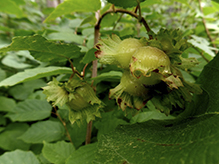 |
|
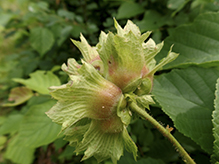 |
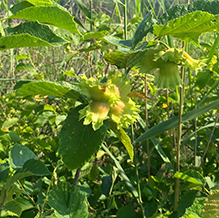 |
|
MinnesotaSeasons.com Photos |
||
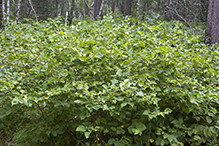 |
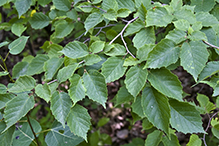 |
|
Plant |
Leaves | |
 |
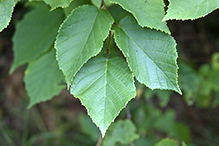 |
|
Leaves |
Leaves | |
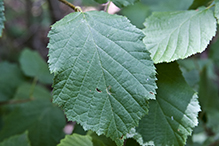 |
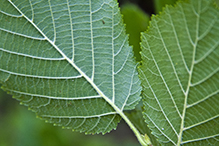 |
|
Leaves |
Prominent veins on leaf underside |
|
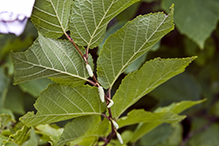 |
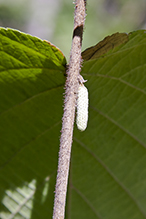 |
|
Male catkins |
||
|
||
|
||
|
Male catkin | |
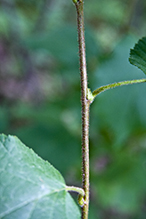
|
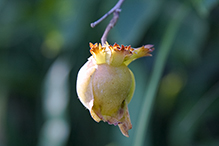 |
|
Fruit |
||
|
||
|
||
Twig |
|
|
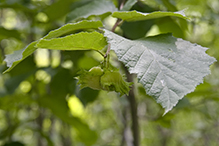 |
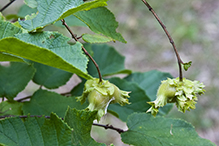 |
|
Fruit |
Fruit |

Slideshows |
|

Visitor Videos |
||
Share your video of this plant. |
||
This button not working for you? |
||
|
Other Videos |
||
Edible Nuts:Hazelnut |
About
Published on Sep 26, 2013 www.tagyerit.com/freefood.htm: Hazelnut ("Corylus americana") is shrub in the birch family that produces tasty nuts in late summer/early fall. They can be used raw or cooked in smoothies, drinks, baked goods or in other ways. Be sure to check out MIWilderness' YT channel for his vid on hazelnut. |
American & Beaked Hazel with John Latimer |
About
Uploaded on Apr 13, 2010 KAXE Phenologist John Latimer talks about American Hazel and Beaked Hazel. While easy to tell apart in late summer, it's harder to differentiate between them in the Spring. At this time of year, the male flower of the Beaked Hazel is fat and slightly curved whereas the American Hazel is longer and generally straight. Also, the new growth on the American hazel is very hairy, and the Beaked Hazel new growth is smooth. |
Hazelnut Harvest ( Part One ) |
About
Uploaded on Aug 13, 2010 Picking Hazelnuts! |

Visitor Sightings |
||
Report a sighting of this plant. |
||
This button not working for you? |
||
Luciearl |
Location: Paul Bunyan State Trail, Crow Wing County |
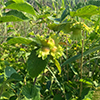 |
| Luciearl 8/8/2018 |
Location: Fairview Twp. |
 |
MinnesotaSeasons.com Sightings |
||
Badoura Jack Pine Woodland SNA Charles A. Lindbergh State Park Forestville/Mystery Cave State Park Hardscrabble Woods / MG Tusler Sanctuary Kellogg Weaver Dunes SNA, Kellogg Weaver Unit Lake Alexander Woods SNA, South Unit Northern Tallgrass Prairie NWR, Rengstorf Unit Sand Prairie Wildlife Management and Environmental Education Area Two Rivers Aspen Prairie Parkland SNA |

|
Created: Last Updated: © MinnesotaSeasons.com. All rights reserved. |
